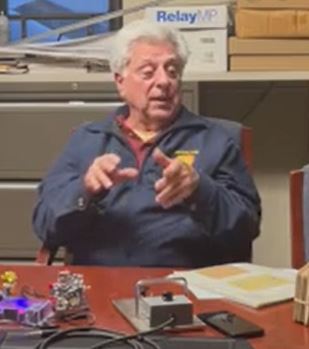Exploring the Fascinating World of CW Operations with Bob Calandra - K2AUF
 This month, we had the pleasure of attending a captivating presentation by Bob, who shared his extensive knowledge and personal experiences with vintage Collins equipment and CW (Continuous Wave) operations. As a lifelong enthusiast and skilled CW operator, Bob’s insights provided a rich glimpse into the history and technical intricacies of amateur radio.
This month, we had the pleasure of attending a captivating presentation by Bob, who shared his extensive knowledge and personal experiences with vintage Collins equipment and CW (Continuous Wave) operations. As a lifelong enthusiast and skilled CW operator, Bob’s insights provided a rich glimpse into the history and technical intricacies of amateur radio.
A Journey into the Past
Bob began by reminiscing about his childhood, where his passion for CW was ignited by his great uncle Charlie, a WWII veteran and early ham radio operator. Charlie’s basement shack in Union, New Jersey, became Bob’s playground, where he learned the code, fostering a lifelong fascination with CW. This early exposure proved invaluable when Bob joined the Navy, where CW proficiency was crucial.
The Navy Experience
Bob’s time in the Navy was marked by rigorous training and practical experience. During boot camp, he learned Morse code basics and later attended an intensive eight-month radio school in Bainbridge, Maryland. His proficiency in CW earned him the position of a radioman on a destroyer, a prestigious role in both the Navy and merchant ships.
Life as a radioman on a destroyer was demanding, with eight-hour shifts involving supervision, CW operation, and message handling. Bob detailed the structured communication protocols and the high level of skill required to maintain efficient and accurate transmissions. The camaraderie and competitive spirit among operators honed their abilities, leading to impressive speeds and unique sending styles, such as the “swing.”
Mastering the Art of CW
Bob demonstrated various keying techniques, highlighting the importance of using the entire hand rather than just the fingers to avoid carpal tunnel syndrome. He showcased a J-38 key and a vibroplex blue racer, explaining the nuances of adjusting weights to control speed. Bob’s Navy training introduced him to different methods of sending code, emphasizing precision and rhythm.
One fascinating aspect Bob discussed was the development of “swing,” a technique used to combine certain dits (short signals) for efficiency and style. This method added a personal touch to transmissions, making them more recognizable among operators. Bob humorously recounted how this technique sometimes annoyed Navy communication technicians monitoring the nets.
CW in Action
Bob shared his experiences during significant historical events, such as the Cuban Blockade and Gemini space missions. These moments underscored the critical role of CW in secure and reliable communication. He also highlighted the elite status of radiomen, who often knew information before the ship’s captain due to their direct involvement in message handling.
The Legacy of Vintage Equipment
Bob’s presentation was enriched by his display of vintage Collins equipment, including the Collins R-390 receiver, renowned for its exceptional performance. He emphasized the durability and reliability of these classic radios, which continue to be treasured by enthusiasts today.
Advice for New CW Operators
For those inspired by Bob’s presentation, he offered valuable advice on starting with CW. He recommended learning a few characters at a time and practicing regularly to develop proficiency. Bob stressed the importance of listening before sending, as recognizing the rhythm and spacing of characters is crucial.
Conclusion
Bob’s presentation was a testament to the enduring appeal of CW and vintage Collins equipment. His personal anecdotes and technical expertise brought to life the rich history of amateur radio, inspiring both seasoned operators and newcomers alike. As we continue to explore the evolving world of communication, Bob’s insights remind us of the timeless value of mastering the art of CW.